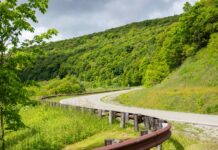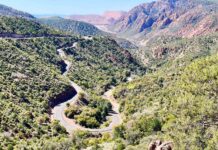Ashtabula County, Ohio—On a sunny Sunday in mid-October, the fall colors were abundant and the weather was perfect for a ride. My friend Chuck Wiley and I decided to meet for breakfast and spend the day riding. Chuck suggested we ride some of the covered bridges in our area and I was on board with that idea. I was thinking it would be just the two of us, but Chuck said we could meet up with the V-Twin Cruisers MC of Northeast Ohio and ride with them. Maybe there would be 40 or so bikes, but I was in for surprise. By the time all bikes had arrived at the designated meet spot, there must have been around 200 bikes. This was going to prove interesting considering most of these bridges are on back-country roads, some of them gravel.

Pennsylvania has the most covered bridges in the U. S. and Vermont has the most covered bridges per square mile in this country, but other states also have an impressive number of these old bridges. Ohio has approximately 138 and Ashtabula County has the most in in the state with 17. Ashtabula County is located in northeast Ohio and is bordered on the north by Lake Erie and the east by Pennsylvania. Many of these bridges were built in the mid 1800’s and have been restored due to the efforts of the Ashtabula County Covered Bridge Committee.
When you think of covered bridges it brings to mind a slower pace of life in years past. Covered bridges have been around for hundreds of years, but we think of the 1800’s and early 1900’s as the time when covered bridges were the norm. These bridges are old fashioned and appeal to tourists and riders alike. Covered bridges were built for two reasons: one is they appear as barns and it was easier to transport cattle across them without spooking them and the other reason is weather protection. Since these bridges are made of wood, a bridge that was not covered would last about 10 years. Bridge builders of the day discovered that if a bridge were covered it would last up to 80 years.

Ashtabula County is just a 30-minute ride on I-90 from my home in northeast Ohio. The majority of these bridges can be reached from I-90 within a few minutes. Every year Ashtabula County has their covered bridge festival the second weekend of October. They offer to the public free maps with tour route highlighted. I have ridden the back roads of the county many times and visited these bridges, but had never ridden during the bridge festival.
One of the reasons you will most likely enjoy this ride is that you are off the beaten path. You are not only riding two-lane state highways, but you will be riding both county and township roads you will not find on the map unless you have a GPS. This country is a combination of farmland and woodlots. In the fall it is especially beautiful with changing colors and little traffic so take your time and enjoy.
Our large group rolled out and headed for the Harpersfield Bridge in Geneva. This is one of my favorites since it is a two-span bridge originally built in 1868. It is 228 feet long and is one lane with a wooden deck as are all these bridges in this county with the exception of one. The bridge is located in a Metro Park with plenty of parking for visitors to take a break and snap a few pictures. Our group did not stop and we rolled through as tourists lined the sides looking puzzled as so many bikes passed over the bridge.
After crossing the Harpersfield Bridge we then turned east to Mechanicsville Road and headed south a short distance to the Mechanicsville Road Bridge, also in Geneva. This bridge was built in 1867 and is believed to be the oldest bridge in the county. Across the road is Grand River Manor, built in the 1800’s. This biker-friendly bar is a good place to stop if you are hungry or just need to relax for awhile.

On our way to the Doyle Road Bridge in Jefferson, the group bypassed the town, but if you choose to go through Jefferson I recommend the Jefferson Diner for a good breakfast or lunch. On the weekends the AC&J Railroad offers tours from Jefferson. This is a 12-mile train ride and a great way to see the countryside if you want to get off the bike for a while. The Doyle Road Bridge is just a couple of miles north of Jefferson. Our group stopped at the Doyle Road Bridge to take a break. There was a local Boy Scout chapter there selling hot dogs and chili along with cold drinks. I guess they knew we were coming. Trying to park 200 bikes on a county road and still leaving room for cages to get by is interesting to say the least.
After our stopped at the Doyle Road Bridge the group rode through the beautiful countryside enjoying the fall colors. With a group this size we would not be able to stop at or ride over all the bridges, but on a nice day like this no one really cared since all of us were enjoying the ride. Some of the bridges we bypassed are the Netcher Road Bridge, the South Denmark Road Bridge, built in 1890, and the Caine Road Bridge, all in Jefferson. A word of caution if you have a problem riding on non-paved roads: Caine Road is hard-pack gravel as are some others. Just a mile north is the Graham Road Bridge in Jefferson. This bridge sits in a small park just off the road. You cannot drive across this bridge, but our group was able to get a good view as we passed by.
After passing the Graham Road Bridge we rode north, passing the Root Road Bridge in Conneaut. The Root Road Bridge was built in 1868 and was restored in 1983. Again we did not stop and continued north, passing by another of my favorites, the Middle Road Bridge in Conneaut. I think the reason this is one of my favorites is that it is more remote than some of the other bridges, possibly because the road is not paved. After the Middle Road Bridge the group rode east on Hatch Corners Road to the State Road Bridge in Kingsville, another one of my favorites, and finally we all got to ride a little gravel. The bridge was built in 1983 and is set in a valley. The back roads in this area, with some rolling hills and curves, are great for riders. Everyone managed to keep their bikes upright on the gravel and after riding over the bridge we were all back on pavement.
The Smolen-Gulf Bridge, completed in October 2008, is the newest covered bridge in the county. This is a modern-day two-lane covered bridge located in Ashtabula. The original covered bridge was built in 1867 and replaced in 1948 with a steel span. The Smolen-Gulf Bridge, 93 feet above the Ashtabula Gulf, is the longest covered bridge in the U.S., spanning 613 feet. There is a parking area on the east side of the bridge so you can stop and get a good look at the structure. As had been par for the day our 200 bikes created a traffic jam at the bridge making a number of cage drivers somewhat unhappy. From this point the group headed for a local biker bar to end the ride and then Chuck and I made one more stop at the Harpersfield Bridge before we headed home.
If you are passing through northeast Ohio, Ashtabula County it has a lot to offer for the rider. This is a chance to ride some great country roads off the beaten path and enjoy some of this country’s history. Whether you tour all 17 bridges or just take a few minutes at one or two it is worth the ride. When you are rolling across I-90 on your way to Laconia or Sturgis, why not take a little extra time to enjoy this part of Ohio? You will be glad you did. (www.coveredbridgefestival.org/2013map-web.pdf)




















